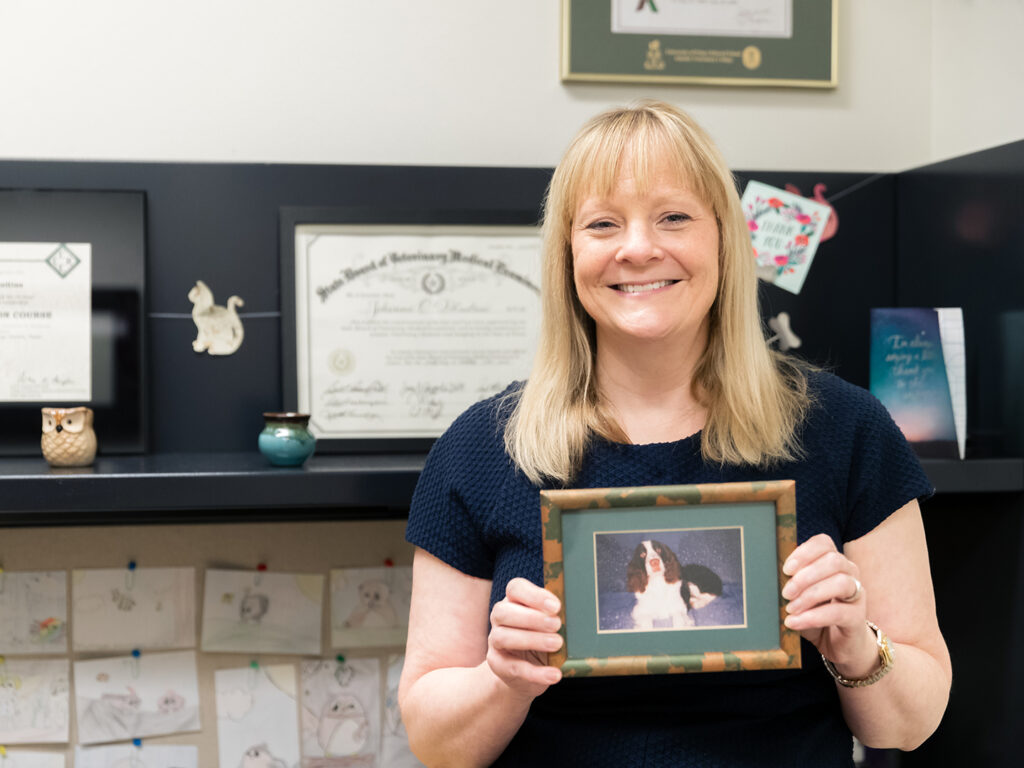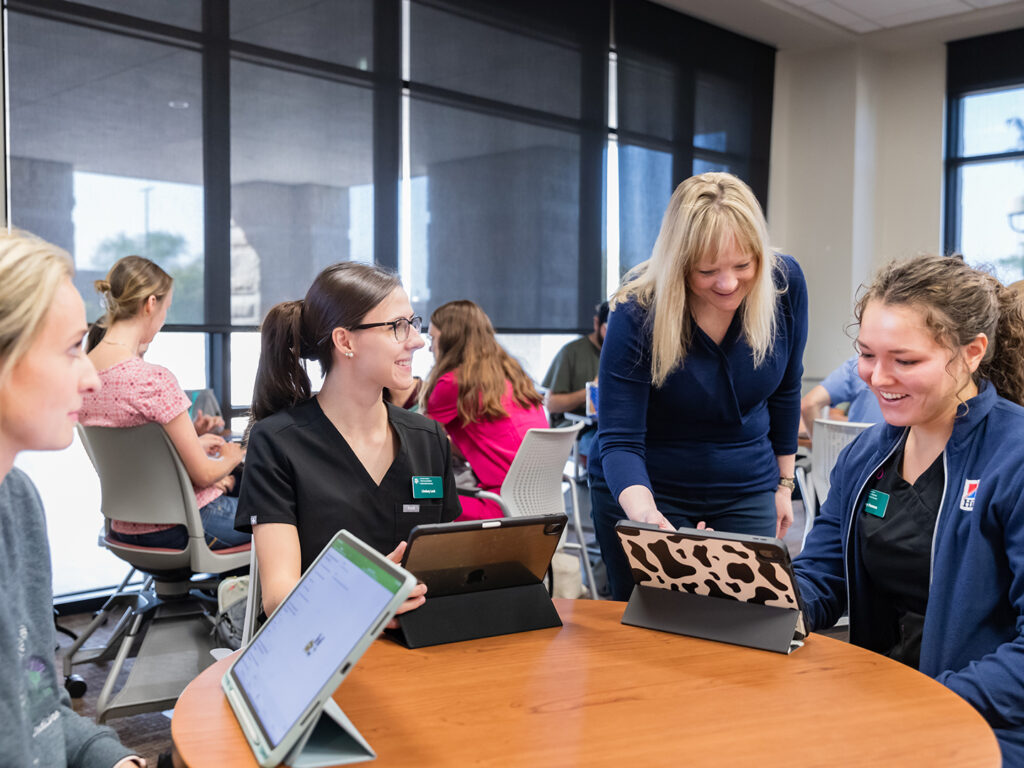Heseltine Combines Love For Veterinary Medicine, Drive To Help Students Succeed
Story by Rachel Knight, VMBS Communications

Photos by Jason Nitsch ’14, Texas A&M School of Veterinary Medicine & Biomedical Sciences
The things we display in our personal spaces tell the story of who we are. A photo shares what we hold dear, an award points out a strength, and a knickknack highlights an interest.
The office of Dr. Johanna Heseltine, a clinical associate professor in the Texas A&M School of Veterinary Medicine & Biomedical Sciences’ (VMBS) Department of Small Animal Clinical Sciences (VSCS), holds the key to her passion for veterinary medicine, her strengths as an educator, and her interest in teaching students what it means to provide gold-standard care.
A Passion For Veterinary Medicine
One of the treasures in Heseltine’s office is a photo of a patient named Peaches, whom Heseltine cared for as a fourth-year veterinary student at the University of Saskatchewan in Canada.
The experience of working with the Springer Spaniel changed the trajectory of Heseltine’s career.
“Peaches was a sweet dog born with a rare heart condition called Tetralogy of Fallot (a birth defect that affects normal blood flow through the heart),” Heseltine shared. “Her condition required open heart surgery, and it’s rare to do open heart surgery on dogs.
“The bypass team at the human hospital came over and did her bypass, and the human pediatric cardiologist assisted our surgeon with the surgery, so human and animal medicine worked together to save Peaches’ life,” she said.
The high-risk surgery required extensive follow-up care for several weeks.
“It was a coincidence that I was the student who ended up with her case, but it influenced the kind of veterinarian that I wanted to be,” Heseltine said. “I looked after Peaches for many weeks, and I had a really strong bond with her and her owners. That experience with her made me want to have that kind of case management and relationship with clients and with animals.”
Flexing Her Strength In Education

Today, Heseltine draws from those kinds of patient experiences to teach her students how to apply what they learn in veterinary school.
Heseltine has served in private specialty practice, teaching hospitals, and academia in various Canadian provinces and American states, giving her a diverse background to pull from in the classroom. Most recently, she has cared for patients as a specialist in internal medicine, taught in a clinical setting, and mentored students at the Texas A&M Small Animal Teaching Hospital (SATH).
In January, however, Heseltine’s career took an unexpected turn after she had a major health condition, leading her to give up her role in the SATH’s Internal Medicine Service.
“My doctor told me to keep my blood pressure very low and to reduce stress associated with work,” she said. “So, now I focus all of my teaching in the pre-clinical years.”
Fortunately, Heseltine still has a wealth of experiences in clinical patient care that comes in handy in the classroom.
“The fact that my experiences are diverse is really helpful,” Heseltine explained. “Working with clients from different socioeconomic backgrounds helps me as a teacher, because I have worked in places where we’re able to do anything, regardless of the client’s finances, but I’ve also been in multiple areas where we’re treating empirically, or without running pricy tests, because that’s the option that’s right for the client financially.”
Rather than teaching students to recall information for a traditional pen-and-paper exam, Heseltine encourages future Aggie veterinarians to apply their knowledge to real-life former cases. She uses medical record writing to teach first-year students, with an emphasis on experiential learning.
“When they start their first year, I co-teach three critical-thinking sessions, which are about clinical reasoning and writing medical records,” she shared. “This is their introduction into thinking about the thought process used when you approach a case and how you capture that in a medical record.”
“I help students overcome this idea that they aren’t ‘good enough’ to pursue their dream in the profession. I make sure they know that if you have that dream and you have the motivation, you should pursue it because you can be successful.”
Dr. Johanna Heseltine
Heseltine also teaches second-year students in critical-thinking sessions that cover a range of health conditions, from coagulation to gastrointestinal diseases and respiratory disease.
“I try to take content that they’re getting in other second-year courses and make applying decisions to patients the focus of these sessions,” she said. “One example of this is an exercise I lead with Dr. Joanne Hardy in which they have to apply everything they’ve learned about respiratory disease in both small and large animal cases.”
Heseltine explained that in the exercise, students review patient videos in which the patients exhibit varying degrees of respiratory distress or disease. Based on the breathing patterns they can see in the videos, the students are then required to determine the next appropriate course of action.
The most rewarding part of the job, according to Heseltine, is seeing her students connect the dots from what they learned in other classes to applying that knowledge in the clinical setting.
“There’s this moment where you see the pieces connect for them,” she shared. “You see them take foundational knowledge and use it in a case to help their patient. Seeing them make those connections is a big part of what is really rewarding about this job.”
Heseltine’s outstanding efforts in the classroom regularly result in awards.
In March, she received the Provost Faculty Teaching Excellence Award, which encourages, recognizes, and rewards faculty who provide students with meaningful experiences, embrace effective teaching approaches, and value student-centered learning.
Heseltine’s efforts and genuine interest in helping her students result in a mutual respect and appreciation.
“Dr. Heseltine is a wonderful clinician,” a student said in a recent course evaluation. “She encourages independent thought and critical thinking. She respects students’ time. She gives students professional advice and recognizes the goals of each student and tailors feedback appropriately.”
Sharing An Interest With Future Aggie Veterinarians

Heseltine’s interest in internal medicine stems from her interest in teaching.
“Internal medicine covers quite a wide variety of topics, and that is rewarding when you’re teaching,” she said. “Part of the reason I chose internal medicine as a specialty was because, at that stage of my career, I knew that I wanted to teach. Because internal medicine is at the foundation of so much of clinical medicine, I felt like that would be a really rewarding area to teach in because it’s relevant to everybody.”
Although Heseltine practiced as an internal medicine specialist, her approach to cases in the classroom is more generalized to better fit her student’s needs.
“I try to help students bridge what they see in the Veterinary Medical Teaching Hospital here to what they’ll see in their future communities by relating the cases we discuss to what they’ll be able to do in general practice,” she said. “I teach my students that gold-standard care doesn’t just mean running every test available; it means providing the highest standard of compassionate care possible while meeting the client’s and patient’s needs using the resources that are available. When we treat the patient, our focus is always on quality of life.”
Heseltine’s definition of gold-standard care is inspired by the compassion she gave Peaches as a veterinary student. It’s the same standard that she now passes on to her students.
“I absolutely love what I do, and I’m so glad that I pursued internal medicine,” Heseltine said. “I help students overcome this idea that they aren’t ‘good enough’ to pursue their dream in the profession. I make sure they know that if you have that dream and you have the motivation, you should pursue it because you can be successful.”
###
Note: This story originally appeared in the Fall 2023 issue of VMBS Today.
For more information about the Texas A&M College of Veterinary Medicine & Biomedical Sciences, please visit our website at vetmed.tamu.edu or join us on Facebook, Instagram, and Twitter.
Contact Information: Jennifer Gauntt, Director of VMBS Communications, Texas A&M College of Veterinary Medicine & Biomedical Sciences; jgauntt@cvm.tamu.edu; 979-862-4216


